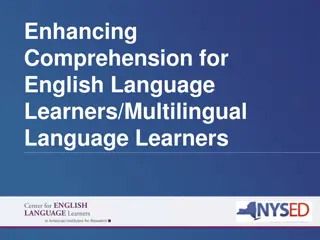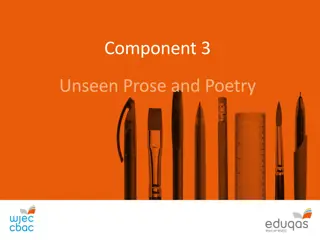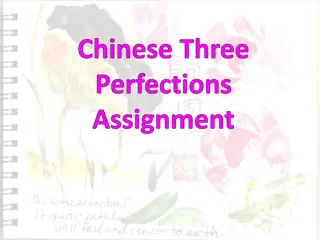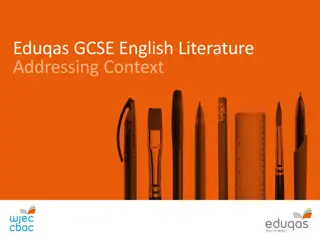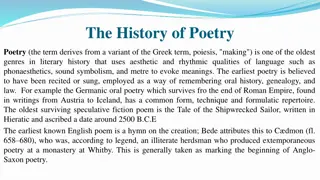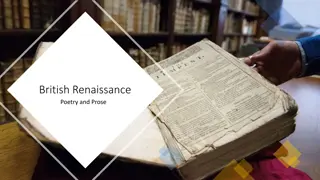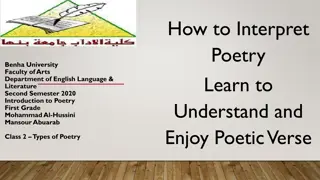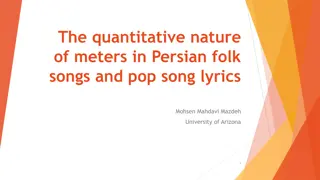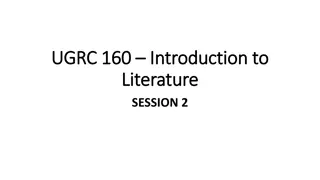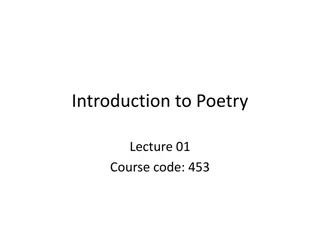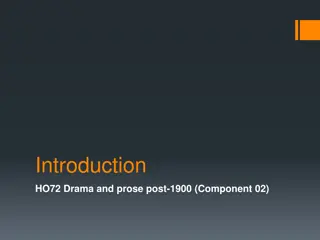Teaching of Prose and Poetry by Nasreen Banu - A Comprehensive Guide for English Learners
Delve into the intricacies of teaching prose and poetry with insights from Assistant Professor Nasreen Banu. Learn about the aims, general objectives, steps, and alternative methods for engaging students in English language learning. Enhance listening and speaking skills through a structured approach to language acquisition.
Uploaded on Jul 05, 2024 | 0 Views
Download Presentation

Please find below an Image/Link to download the presentation.
The content on the website is provided AS IS for your information and personal use only. It may not be sold, licensed, or shared on other websites without obtaining consent from the author. Download presentation by click this link. If you encounter any issues during the download, it is possible that the publisher has removed the file from their server.
E N D
Presentation Transcript
TEACHING OF PROSE AND POETRY NASREEN BANU S ASSISTANT PROFESSOR DEPT OF ENGLISH
TEACHING OF PROSE Prose is meant for learning a language. Teaching prose means teaching reading with comprehension. The learners are taught the skill of reading. The next step is to teach them reading with comprehension. Reading with comprehension helps the learners to acquire new vocabulary and content words. The power of comprehension can be promoted through reading and listening.
AIM OF TEACHING PROSE The main aims of teaching prose are a) literary and b) content To achieve the literary and content, the aims of teaching of prose should be intensive and extensive.
GENERAL AIMS OF TEACHING PROSE To enable the students To understand the passage and grasp its meaning. To read with correct pronunciation, stress, intonation, pause and articulation of voice. To enable students to understand the passage by silent reading. To enrich their active and passive vocabulary. To express the ideas of the passage orally and in writing. To enjoy reading and writing. To develop their imagination. To prepare the students for world citizenship.
STEPS FOR TEACHING PROSE The steps for teaching of prose may be summed up as follows. 1. Introducing the prose lesson 2. Teaching structures 3. Dividing the text into smaller units 4. Teaching vocabulary 5. Model reading by the teacher 6. Silent reading by the students 7. Testing comprehension 8. Testing application 9. Loud reading by the students and 10. Giving assignment
ALTERNATIVE LEARNING METHOD FOR PROSE LESSON ABL Activity Based Learning Activity based learning is a new ladder approach in the teaching of English language. It is a simplified process of teaching and learning. In the Activity Based Learning, the following activities are included in the learning process.
LISTENING SKILLS Rhymes The letters of the Alphabet The words relating to home, school environment Greetings and responses Informal Conversations Simple Commands & instructions
SPEAKING SKILLS Asking and answering simple common questions Making polite requests Saying, Thank you , and Sorry whenever necessary Asking for permission Expressing their needs
READING SKILLS Recognizing lower and upper case of letters of English Reading words with pictures Reading words without pictures Reading words
WRITING SKILLS Drawing and painting Drawing lines & curves leading to writing Writing letters of the alphabet Writing words
TEACHING OF POETRY Poetry is the highest form of literary expression. It is a work of perfect. It appeals to the emotion. It has an aesthetic effect on human mind. Poetry is different from prose. Prose is for information and poetry is for appreciation. It gives details and facts in a beautiful form. It is highly rhythmic in character. Each and every poem is a piece of literature.
TEACHING RHYMES 1. Rhymes strengthen and develop the memory power of learners. 2. They develop active power of imitation and imagination. 3. Rhymes widen the knowledge of vocabulary. 4. Rhymes lay a strong foundation for speech work. 5. A sense of achievement and confidence is developed in the young learners. 6. Rhymes train the ears to the varieties of sounds and rhythm. 7. Rhymes are an excellent aid to correct speech. 8. Rhymes develop the skills of listening and speaking.
SUGGESTIONS FOR TEACHING A POEM 1.The message of a poem is more important than the details. 2. The main theme of the poem is to be grasped (understood). 3. Explanation and paraphrasing does not create any enthusiasm. 4. The teacher should present the poem orally with correct pronunciation and rhythm. 5. Students concentrate all their attention in listening if the poem is read aloud. 6. Verbal peculiarities should be neglected. 7. Students appreciation and understanding of the poem and poet s experience can be expressed in the form of drawing. 8. Encourage pupils to do activities at the end of the class.
PROCESS OF TEACHING A POEM There are 3 main stages in the process of teaching a poem. 1. Preparation 2. Presentation 3. Discussion
PREPARATION 1. The main outline of the poem is to be understood by the students by equipping them. 2. Familiarise the students with important words and expressions 3. Ensure that the ideas of the poem are reachable and comprehensible by the students. 4. This can be done by getting responses through simple questions by the teacher.
PRESENTATION The teacher reads the poem or recites with proper pronunciation, intonation, gestures and facial expressions. If necessary this can be repeated by the teacher.
DISCUSSION The teacher need not explain every word or every line of the poem. Simple questions may be asked to ensure their understanding of the poem. The teacher uses pictures to explain the meaning of difficult words. The teacher can pose questions to the class to get meanings for difficult words.
OUTCOME OF TEACHING OF POEM 1. Preparation is equipping the students for quick understanding. 2. Presentation involves reading, re-reading, elucidation of answers, kindling interest and calling for intense concentration on the words, rhymes, rhythm, imagery etc., in the poem. 3. Discussion leads the pupils to a thorough knowledge of the poem.
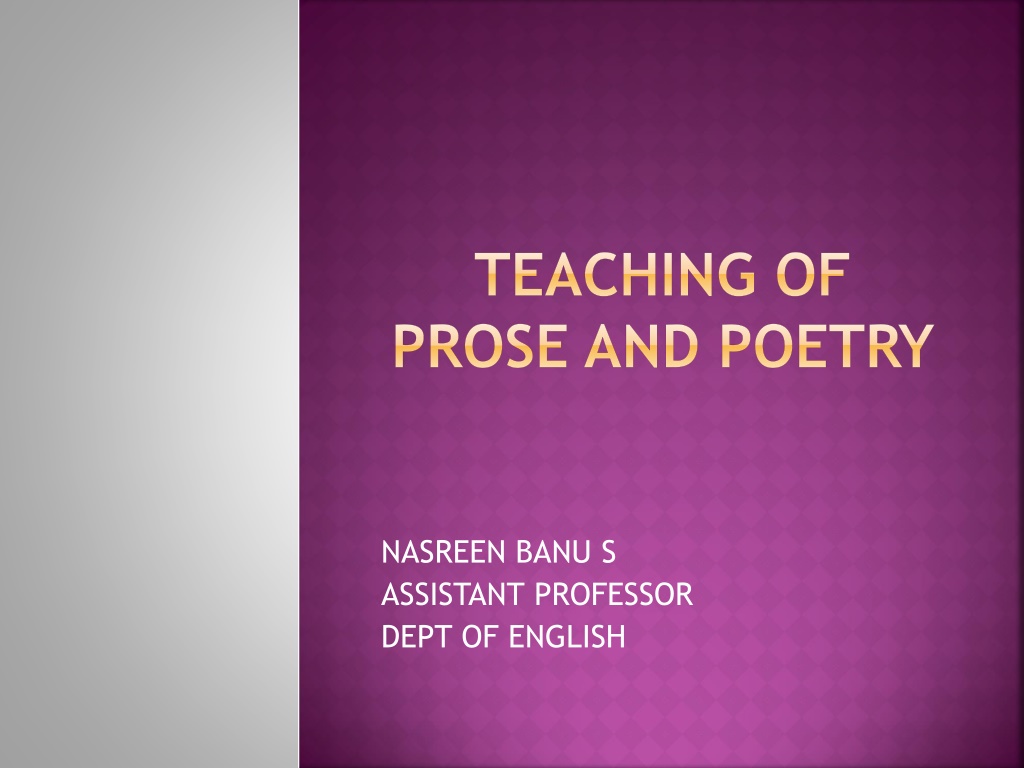
 undefined
undefined







